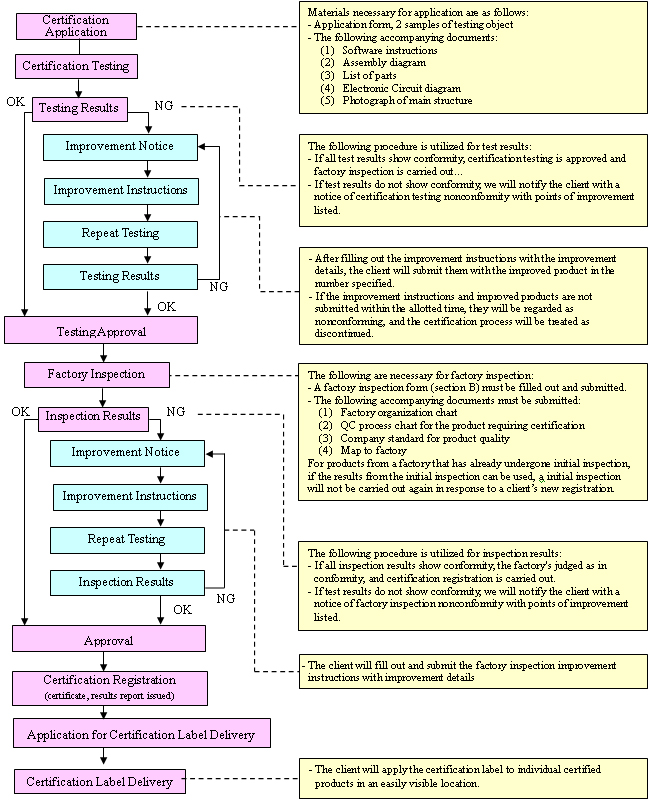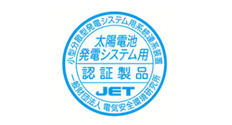
- S-JET Certification
- Circuit Breakers for residences
- Components and Materials/CMJ Registration
- Certification of Water Supply Apparatus
- Low-voltage grid connected inverters (Power conditioners)
- JET PVm Certification
- JET PV System Operation & Maintenance certification (JET PV O&M certification)
- NRTL Certification
- JET Robot Certification
- Testing and Certification of ECHONET Lite / AIF Specification







- Home
- Certification
- Low-voltage grid connected inverters (Power conditioners)
JET’s certification system is the system to carry out product testing to ensure conformity to JET’s certification testing standard prepared based on the Grid-interconnection Technical Requirement Guidelines (currently the Grid-interconnection Technical Requirement Guidelines on Quality of Electricity and the Official Interpretation of Technical Requirement of Electric Facilities under the Electricity Utilities Industry Law) and the Electrical Appliance and Material Safety Law etc., and also carry out a factory inspection to ensure that continued production of the products equivalent to this model is possible and then, issue the certification to the approved products.
For the main purpose of insuring safety in small distributed generation systems for household use as well as smoothing grid-interconnection procedure, JET accepts applications from manufacturers, distributors, and importers of grid-connected inverters (power conditioners) of small distributed generation systems (hereafter referred to as “Low-voltage grid-connected equipment”), and issues certification after carrying out certification testing and factory inspection.
For equipment that has received JET certification, it is possible to omit individual performance confirmation tests in interconnection discussions between general power transmission and distribution business operators and installers of power generation facilities, etc., so it is expected that the time required for discussions and examinations will be shortened.
Products eligible for certification include the following low-voltage grid-interconnection equipment, etc, utilizing inverter, etc. Products conform to requirements for Low-voltage grid-interconnection Protection.
Devices Operational Rule
- For photovoltaic generation system, single-phase output less than 20 kW, and three-phase with output less than 50 kW (for multiple interaction type photovoltaic inverters, single-phase with output less than 20 kW, three-phase with output less than 50kW)
- For gas engine cogeneration systems, output less than 10kW (for multiple interaction type, less than 10kW)
- For stationary small fuel cell systems, output less than 10kW (for multiple interaction type, less than 10kW)
- For charge / discharge systems for stationary lithium-ion storage battery, output of 10 kW or less (for multiple interaction type, 10 kW or less)
- For multiple inputs of photovoltaic strings and stationary lithium-ion storage battery, output 10 kW or less.
- For multiple inputs of gas engine cogeneration and stationary lithium-ion storage battery, output less than 10kW.
- For multiple inputs of stationary residential-size fuel cell and stationary lithium-ion storage battery, output less than 10 kW.
- For storage batteries (DC connection type) installed in electric vehicles, etc., output less than 10kW.
- For multiple inputs of solar cells and storage batteries (DC connection type) installed in electric vehicles, etc., output less than 10 kW.
- For multiple input systems of storage batteries installed in electric vehicles (DC connection type), stationary lithium-ion storage batteries, and solar batteries, output less than 10kW ( if storage batteries installed in electric vehicles (DC connection type is not included, 10kW or less)
The process for certification is displayed in Diagram 1

The process for certification is displayed in Diagram 1
- Certification Application
Application for certification requires that the applicant submit the identification number (model number) of low-voltage grid-connected equipment, in the same condition as one that can be sold as a certified product. - Certification Testing
Certification testing verifies that low-voltage grid-connected equipment , has protective functions, performance, and safety conforming to the certification testing standard. - Factory Inspection
A factory inspection is carried out initially and on a general yearly basis in order to verify that quality control standards allow continued production of a product conforming to the certification testing standard. - Certification Registration
Products conforming to the certification testing and factory inspection will undergo certification registration, and be publicly notified (currently on the JET homepage). - Certification Period of Validity
Certification is valid for five years. However, in the event of a revision to the Grid-interconnection Code (JEAC 9701, JEA), etc., the period of validity may be shortened with advance notification if necessary. - Certification Label
Until the certified products are shipped from the manufacturing factory, the certification label below should be applied to certified products in an easily visible location.
Example certification label

Testing method related to the certification process for low-voltage grid-inter connection involves general rules of testing methods compiling common items of each system as well as the testing methods describing individual testing items of each system. The certification testing process is carried out based on the combination of the above, the general rules and the individual methods appropriate to the particular power generation system.
- General Rules for Test Method of low-voltage Grid-connected Protective Equipment etc.
- Individual Test Method of Grid-connected Protective Equipment etc. for Grid-connected PV Power Generating Systems (for PV Power Generating Systems)
- Individual Test Method of Grid-connected Protective Equipment etc. for Grid-connected Gas Engine Cogeneration Systems (for Gas Engine Cogeneration Systems)
- Individual Test Method of Grid-connected Protective Equipment etc. for Grid-connected Stationary Fuel-Cell Power Generation Systems (for Stationary Fuel Cell Power Generation Systems)
- Individual Test Method of Grid-connected Protective Equipment etc. for Multi-unit Grid-connected PV Power Generating Systems (for PV Multi-unit Grid-interconnection Systems)
- Individual test method for grid interconnection protection device for storage battery system (for storage battery)
- Individual test method for grid interconnection protection device for multiple DC input system (PV + BS) (for PV + BS)
- Individual test method for grid interconnection protection device for multiple DC input system (GE + BS) (for GE + BS)
- Individual test method for grid interconnection protection device for multiple DC input system (FC + BS) (for FC + BS)
- Individual test method (for EV) for grid interconnection protection devices for storage batteries (DC connection type) mounted on electric vehicles, etc.
- Individual test method for grid interconnection protection device for multiple DC input system (PV + EV) (for PV + EV)
- Individual test method for grid interconnection protection device for multi-input system (for multi-input)
The certification testing consists of functionality verification of various protective functions of grid-connected inverter such as automatic separation of power generation system from the grid system at the time of distribution line problem, power outage, power generation system problem etc. as well as performance testing for stability and environmental resistance against change in the inverter’s direct current input, change in load, or other disturbance incoming from the power supply system etc. Tests can be classified in the 12 types below, with a total of 50 test details.
- Construction test
- Insulation performance (insulation resistance, power frequency withstand voltage, lightning impulse withstand voltage)
- Protective functions(simulated input tests: AC over-current, DC overvoltage and under-voltage, DC-component detection, actual operation tests: AC overvoltage and under-voltage, frequency rise and drop, reverse power flow prevention, reverse charging prevention, frequency feedback function, step injection function, islanding prevention 1, islanding prevention 2, fixed time closing block after reenergizing, instantaneous (unbalanced) overvoltage.
The protection level and operating time of protective functions necessary to grid connection (voltage, frequency abnormalities, islanding protection functions, etc) shall be within specifications. - Steady-state characteristics(AC voltage following, frequency following, operation power factor, output harmonic current, leakage current, suppression function for voltage rise, temperature rise, soft start functions)
Basic features such as the inverter’s output power factor to the distribution line and current distortion levels shall be within specifications. - Transient response characteristics (sudden input power change, sudden grid voltage change, sudden grid voltage phase change (10 degrees), sudden grid voltage phase change (120 degrees), sudden grid voltage imbalance.)
Functionality of the inverter’s output in the event of sudden changes in solar radiation or distribution line voltage shall be stable. - External faults (AC short circuit, instantaneous voltage drop, load interruption)
Functionality of the inverter’s output in the event of an instantaneous voltage drop shall be stable.
- Electromagnetic emission(radiated disturbance, conducted disturbance)
The inverter shall not create adverse effects such as radio noise, conducted disturbance etc. to outside - Electric Environment Resistance(grid voltage distortion resistance, grid voltage imbalance, surge immunity, imbalance, 5 other items)
The inverter shall not have reactive malfunctions as a result of distribution line voltage distortions, surge voltage, or other external noises. - Ambient environment resistance(humidity, humidity-freeze cycle, wet)
The insulation performance of the inverter in its stationed environment (humidity conditions) shall be maintained. - Durability
The performance of switches and other parts with mechanical movement shall be ensured. - Parts failure
- Isolated operation
* Based on the specifications and generation systems of the product, some tests may not be carried out.
If you would like the latest version of the general test method for low-voltage grid interconnection protection devices and the individual test method for each system (hereinafter referred to as the test method), you can apply by clicking the button below.
Jump to Japanese page
| Document | Form | |
|---|---|---|
| Certification of Low-Voltage Grid Interconnection Protection Devices Operational Rule | PDF |
|
| Certification (update) application | WORD |
PDF |
| Power of Attorney | WORD |
PDF |
| Testing at Manufacturers’ Premises | WORD |
PDF |
| Factory Inspection Report (Form B) | WORD |
PDF |
Contact the following for further information
| Power Technology Testing Laboratory | ||
|---|---|---|
| TEL:+81-45-570-2075 | FAX:+81-45-570-2077 | E-mail:jet-grid@jet.or.jp |
Last Update:2025.01.29



